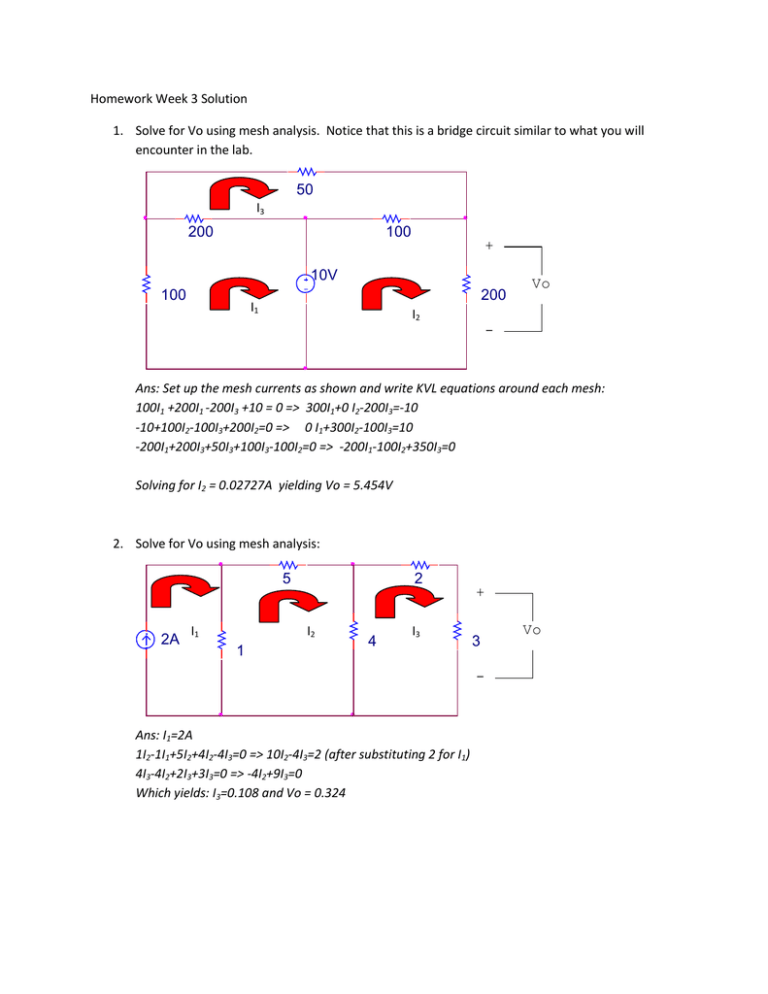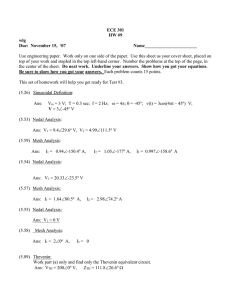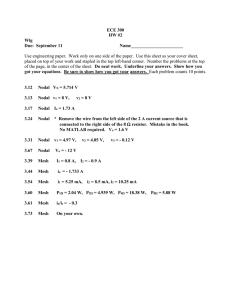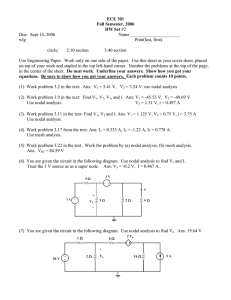Homework 3 Solution
advertisement

Homework Week 3 Solution 1. Solve for Vo using mesh analysis. Notice that this is a bridge circuit similar to what you will encounter in the lab. 50 I3 200 100 + 10V 100 200 I1 I2 Vo - Ans: Set up the mesh currents as shown and write KVL equations around each mesh: 100I1 +200I1 -200I3 +10 = 0 => 300I1+0 I2-200I3=-10 -10+100I2-100I3+200I2=0 => 0 I1+300I2-100I3=10 -200I1+200I3+50I3+100I3-100I2=0 => -200I1-100I2+350I3=0 Solving for I2 = 0.02727A yielding Vo = 5.454V 2. Solve for Vo using mesh analysis: 5 2A I1 2 I2 1 4 I3 + 3 - Ans: I1=2A 1I2-1I1+5I2+4I2-4I3=0 => 10I2-4I3=2 (after substituting 2 for I1) 4I3-4I2+2I3+3I3=0 => -4I2+9I3=0 Which yields: I3=0.108 and Vo = 0.324 Vo 3. Solve for Vo using mesh analysis: 3V Ic 200 100 10V Ia 100 + Ib 200 Vo - Ans: This yields the following mesh equations: 10=-300Ia+0Ib+200Ic 10=0Ia+300Ib-100Ic 3=200Ia+100Ib-300Ic Which yields Ib=0.0175 and Vo=3.5V 4. Solve for Vo using mesh analysis: 1V 2 + Ia 2A Ib 1 4 Ic 3 - Ans: Ia=2 -1Ia+1Ib-1 +4Ib-4Ic=0 => 3= 5Ib-4Ic 4Ic-4Ib+2Ic+3Ic=0 => 0=-4Ib+9Ic Solving for Ic: Ic=0.414A and Vo=1.241V Vo 5. Solve for Vo using mesh analysis: 3 4 1A 2V Ia + Ib 5 Vo - Ans: The presence of the 1A current source means a supermesh will have to be created. However, you still draw the two currents Ia and Ib as shown. We can write immediately: Ib-Ia=1A Writing the supermesh equation yields: -2+3Ia+4Ib+5Ib=0 => 2=3Ia+9Ib Together with the first equation, we solve for Ib=0.4167 which gives Vo=2.083V 6. Solve for Vo using mesh analysis. Note direction of I and dependent current source. 2 Ia 1V 100 + I Ic Ib 10 20 Vo 0.1I - Ans: Note that even though the current source is a dependent source, we still treat it the same as an independent source and write a super mesh around it. We can write two relations concerning the current source immediately: I = Ia-Ib 0.1I=Ib-Ic These two equations can be combined to eliminate I as a variable: 0.1(Ia-Ib)=I b-Ic which simplifies to: 0.1Ia-1.1Ib+Ic =0 Writing the first mesh equation yields: -1 +2Ia+10Ia-10Ib=0 => 1 = 12Ia-10Ib+0Ic The super mesh gives the final equation: 10Ib-10Ia+100Ib+20Ic=0 => 0=-10Ia+110Ib+20Ic Solving for Ic= 0 and therefore Vo = 0. Note: This result was due to a typo in the assignment. I normally do not like to put you through a lot of work to get zero, unless it is to demonstrate a useful principle. 7. Solve for Vo using NODAL ANALYSIS: 10Vi Va Vb Vc + - 10 + + 2V Vi 20 20 - Vo - Ans: Marking the nodes as shown and writing the nodal equation (with the super node around the dependent voltage source) yields: Va Vb Vb Vc 10 20 20 Vi Vb Vc Vb 10Vi 10Vb Vc 11Vb Vc Vb 11 2 Va Substituting the last two relations into the first and solving for Vc = 3.143V 8. Do problem 3 using superposition. Ans: Replacing the 10V source with a short gives Vo=-1.5V Replacing the 3V source with a short and replacing the 10V source gives Vo= 5V. The sum of the two results gives Vo=5 – 1.5 = 3.5V, the original result. 9. Do problem 4 using superposition. Ans: Replacing the 1V source with a short allows the 1 ohm and 4 ohm resistors to be placed in parallel for 0.8 ohms. Current division of the 2A source gives: 0.8 I 3 2 A 0.276 2 3 .8 Vo 3(0.276) 0.828V Replacing the 1V source, removing the current source and simplifying the circuit by paralleling the 4 ohms with the 2 and 3 ohm resistors (5 ohms in parallel with the 4 ohms) gives 2.22 ohms. This forms a voltage divider with the 1 ohm resistor to give 0.69V across the 4 ohm resistor. Using voltage division again gives: 3 Vo 0.69 0.414V 23 The sum of the two responses gives: 0.828+0.414 = 1.242V the result from before (+/- rounding errors). 10. Solve for Vo in the bridge circuit below. First use NODAL analysis. Then solve it again using MESH analysis. Which is easier? (Watch the signs on Vo). Vo - + 50 10 12 10 1A 3 11 Ans: Nodal analysis is slightly simpler here even though there is a supermesh due to the current source. The supermesh still involves one more equation to deal with, giving 4 equations. Nodal analysis requires only 3 equations. However, nodal analysis requires the combination of fractions were mesh analysis requires the combination of products, which is simpler. Many times the choice of analysis is mainly personal preference. In any case, Vo = -0.04182V given the polarity shown for Vo. This is another form of bridge circuit.






